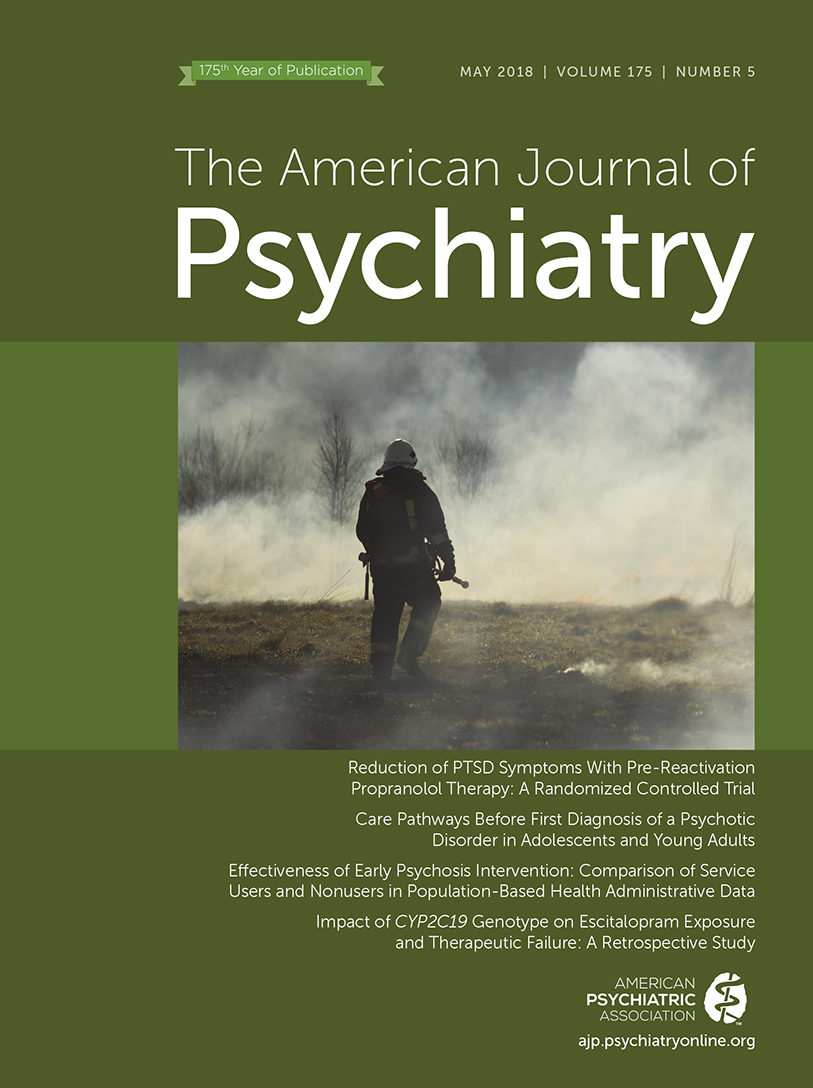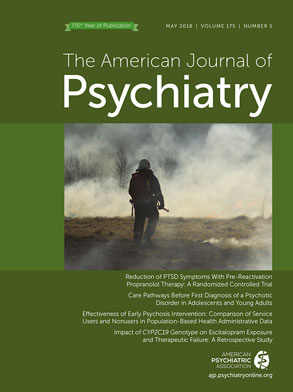Prevention is a long-sought goal in psychiatry, and while primary prevention requires etiological knowledge we do not yet possess, secondary prevention, to minimize adverse illness effects, is a feasible objective. In the early 1990s, researchers identified long delays, averaging many years, between the onset of psychosis and the initiation of treatment (
1) and found extended duration of untreated psychosis to be associated with more severe symptoms and poorer outcomes (
2,
3). The effects were small in magnitude and did not affect quality of life, employment, or hospitalization (
3), and researchers were clear that while prolonged duration of untreated psychosis was a possible cause of poor outcomes, prolonged untreated psychosis and poor outcomes might both be caused by other factors, such as lack of insight and/or motivation for treatment.
Two Approaches to Intervention
This research stimulated two types of early intervention studies. The first focused directly on the benefits of reducing the duration of untreated psychosis and compared outcomes in communities that made broad efforts to shorten duration of untreated psychosis with outcomes in control communities with longer duration of untreated psychosis (
4). Outreach efforts and public education were able to substantially reduce duration of untreated psychosis in the experimental communities, with better symptom outcomes after 5 years and greater employment outcomes after 10 years. It has been virtually impossible to rigorously study early versus late intervention because it would be unethical to delay intervention as part of an experimental study design.
A second set of more conventional trials compared intensive coordinated care and standard care in early-episode psychosis, which is not really a comparison of early versus late intervention but rather of intensive versus usual care in newly diagnosed psychosis. Meta-analyses demonstrate significant clinical improvements for periods of 1–2 years, although benefits are less substantial over more extended periods (
5–
7). Most recently, the National Institute of Mental Health–funded Recovery After an Initial Schizophrenia Episode–Early Treatment Program showed benefits in quality of life and symptoms over a 2-year follow-up for multicomponent coordinated care, with the greatest benefits observed for patients with shorter duration of untreated psychosis (
8). Early intervention thus appears promising, although it is not yet clear whether shortening duration of untreated psychosis itself improves outcomes.
Foundations for Dissemination
In spite of these ambiguities, many urge that early intervention for psychosis be widely implemented. Two challenges for successful implementation not addressed by randomized trials are population-based case identification and the monitoring of program implementation and outcomes in real-world practice. Two articles in this issue are among the first to address these issues.
Simon et al. (
9) assembled a remarkable data set based on 4.7 million young people seen in five large Kaiser Permanente health systems over a 7-year period. They used this huge population sample to address the question of where first-episode psychosis patients are treated before the onset of psychosis. They first identified a subset of 624 patients with validated diagnoses of psychotic disorders and then documented this group’s use of services in the previous 3, 12, 24, and 36 months. Among these patients, only 8% had a psychiatric hospitalization in the 12 months before their psychosis diagnosis, but 29% used some specialty outpatient mental health care, 65% had a psychiatric diagnosis other than psychosis, and 91% used some health services. Thus almost all were “in the system,” at least in Kaiser Permanente, and thus were potentially identifiable as “at risk” for psychosis up to 3 years before the diagnosis was made. If identifying prepsychotic patients is like looking for needles in a haystack, Simon and colleagues have mapped the haystack and shown that almost all the needles are in it. The challenge is finding them.
In the second phase of their study, Simon et al. compared the proportions of “prepsychotic” patients who used various services with the proportions of patients with major depressive disorder or patients without any psychiatric diagnoses. Those who were eventually diagnosed with psychosis were 17.1 times more likely to have a psychiatric hospitalization in the year before the psychosis diagnosis than other patients seen in the Kaiser system, 12.6 times more likely to use any mental health specialty care, and 6.3 times more likely to have any psychiatric diagnosis.
The good news of this analysis is that the authors demonstrate a well-bounded universe in which most prepsychotic patients are seen well before the onset of psychosis. These patients could potentially be identified if an accurate prognostic test were available. The not-so-good news is that service use data in themselves do not go very far toward identifying high-risk patients. Psychosis is rare, and calculations for this commentary using Bayes’ theorem estimate that only 6.3% of psychiatric inpatients, 1.5% of all specialty mental health patients, and 1.2% of all patients with mental health diagnoses in a given year soon develop psychosis. High-risk patients thus cannot be readily identified with service use data alone. Simon and colleagues optimistically hope that screening tools can be developed to identify these patients, but one recent review concluded that such tools currently appear to be “unreliable across populations and settings” (
10).
Perhaps a more realistic conclusion from this remarkable data set is that while most prepsychotic patients are in the health care system well before onset of psychotic symptoms, identifying them will be challenging. In addition, any screening for rare events poses a high risk of false positive identifications, leading to anxiety for families who are told that their child is at risk for a dreadful disease, even if it is one that is unlikely to emerge.
While Simon et al. hope to facilitate case identification before the onset of psychosis, my reading of their data is that they provide an invaluable map for efforts to identify psychotic diagnoses as soon as they do occur—a more achievable goal and one that avoids the risk of “false positive” stigmatization. Efforts might best go toward development of rapid alert systems so that as soon as psychosis is diagnosed, specialized intensive treatment can be offered.
In the second article, Anderson et al. (
11) address the complementary challenge of assessing program performance using real-world regional administrative data. Data from participants in an early psychosis intervention (EPI) program in Ontario were compared with a carefully matched comparison group over a 2-year acute treatment period and an additional 2- to 5-year follow-up period. Data on service use show that EPI participants had better access to psychiatric services and, perhaps in consequence, made less use of primary care services and emergency department services. Unexpectedly, they had greater rates of hospitalization. There were no differences in suicides, but, most dramatically, EPI participants had substantially less nonsuicide mortality. In the posttreatment period, the advantages in access to psychiatric services persisted, but so did increased hospitalizations, specifically involuntary hospitalizations, while differences in mortality were no longer significant. The authors attribute the differences in mortality to suicides that were misclassified as medical deaths, which is a possibility, but it also appears that the groups were not matched on medical risk factors, and it is thus possible that the EPI program excluded patients with serious medical problems. Data on service use seem clear, but the outcome findings must be regarded as mixed and/or ambiguous because of the inevitable imperfections of comparisons based on administrative data. These ambiguities might represent serious shortcomings in a randomized clinical trial, but if we understand this study as a prototype of a real-world program-monitoring effort, we recognize these limitations as unavoidable features of outcome monitoring based on real-world data.
These two studies thus move the effort to provide timely intensive care for people with early-onset psychosis past the realm of randomized effectiveness trials toward the goal of real-world implementation with ongoing program evaluation. Regardless of the ambiguities or uncertainties in meta-analyses of experimental data, the goal of providing timely, appropriately intensive services to all young people with psychiatric illnesses is a goal very much worth reaching for and one that is advanced by these two studies.

